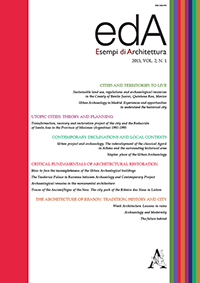Estratto da
ESEMPI DI ARCHITETTURA
International Journal of Architecture and Engineering
Sustainable land use, regulations and archaeological resources in the county of Benito Juarez, Quintana Roo, Mexico
ESEMPI DI ARCHITETTURA
International Journal of Architecture and Engineering
Sustainable land use, regulations and archaeological resources in the county of Benito Juarez, Quintana Roo, Mexico

We analyzed the three main planning documents used by the County of Benito Juarez in the State of Quintana Roo, Mexico: POEL, PMDUS, and POET. The POEL provides overall ecological regulations for the county, the PMDUS, applies specifically to infrastructure development, and the POET applies to coastal development along the “Rivera Maya” between the cities of Cancun and Tulum. The POEL does not provide any criteria, or specific spatial planning zones (UGAS), focused upon archaeological resources or cultural preservation. Of the 22 UGAS defined, none require the consideration of archaeological resources prior to development. One of the general planning criteria, CG-07, that applies to all UGAS requires that if archaeological resources are discovered during development, permission to continue must be received from the National Institute of Anthropology and History (INAH). However, our research indicates that CG-07 has never been complied with. Thus, federal laws to protect archaeological resources are not effective at the county level. For example, INAH has identified 23 archaeological sites in the county. However, the County only acknowledges three. PMDUS, applies specifically to infrastructure development and requires a balance between social and economic needs. Recreation, sports, education, and culture must be considered in infrastructure planning. The PMDUS, though, does not consider the protection or conservation of archaeological resources. The POET applies to coastal development along the “Rivera Maya” between Cancun and Tulum. There are two specific criteria that apply to archaeological resources: TU-43 and TU-44. TU-43 is similar to CG-07 of the POEL and requires the notification of INAH when archaeological resources are discovered. TU-44 requires the same notification, but specifically applies to sacbeobs, archaeological Maya roads. As with CG-07, our research indicates that TU-43 and TU-44 are not effective for the protection and management of archaeological resources. We conclude that while the County of Benito Juarez, and the State of Quintana Roo use Maya archaeological sites and culture as a major marketing tool in the promotion of tourism, their largest economic industry, both the design and implementation of regulations are not effective in the recording, studying, evaluating, and mitigating these nonrenewable resources. Rather than leaving archaeological decisions to the federal authorities at INAH, local government planners must embrace their mandate to balance development with social, cultural, and societal needs and incorporate input from local communities and archaeological experts.
| pagine: | 9-20 |
| DOI: | 10.4399/97888548858682 |
| data pubblicazione: | Luglio 2015 |
| editore: | Aracne |








